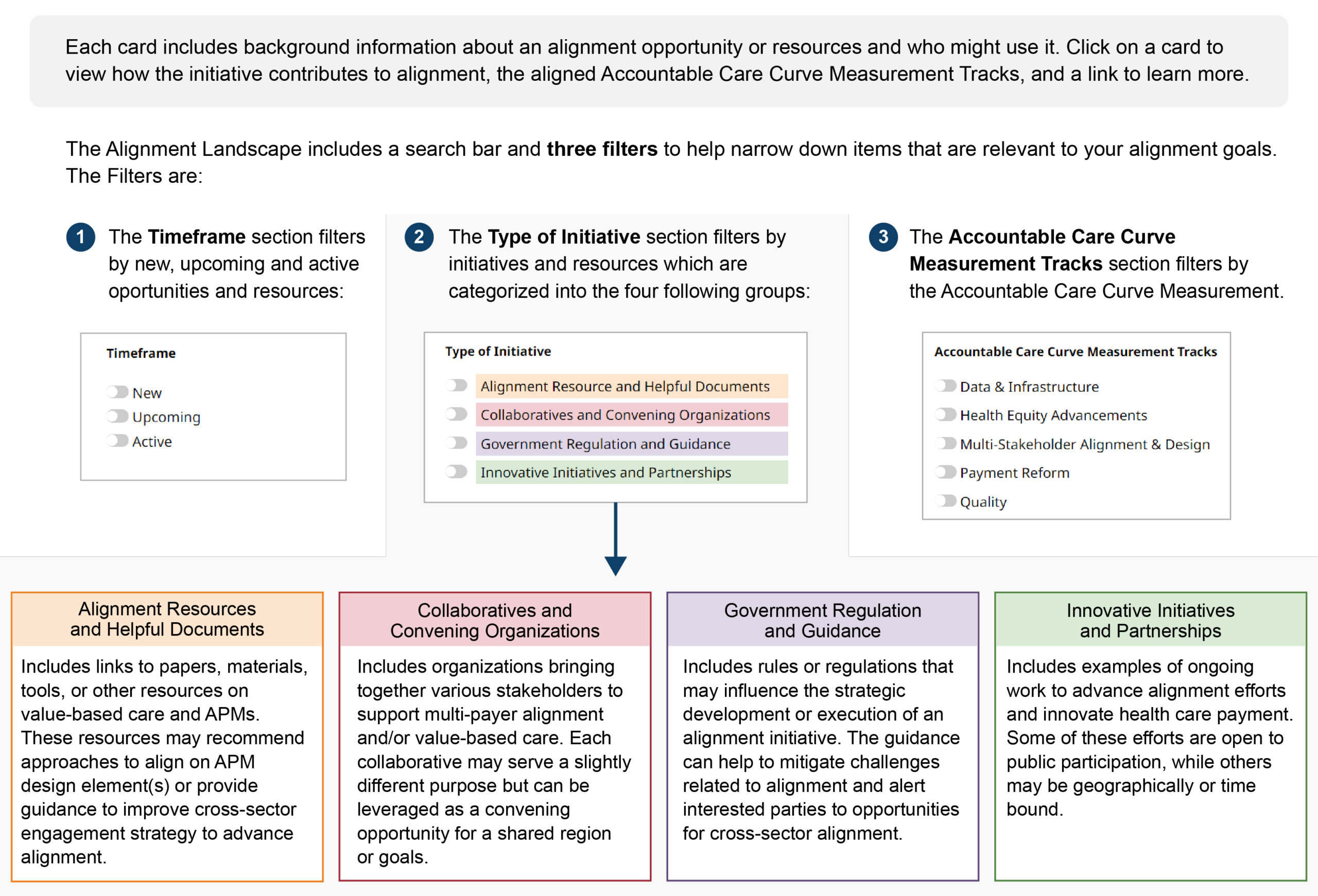- March 21, 2016
- Posted by: Health Care Payment Learning & Action Network
- Category: Blog

Over the past decade there have been numerous efforts to better align performance measures across payers in both the private sector and public programs. Building on these efforts and with the advancement of alternate payment models (APMs), the Core Quality Measures Collaborative (CQMC) achieved the first step in refining measures, reducing burden and recognizing high value measures.
In mid-February, the CQMC reached an important milestone when it released seven core measure sets to support accountability and quality improvement in selected areas of practice. These measure sets are designed to help commercial and government payers align the way they assess health care quality. The availability of sets of uniform and consistent standards helps streamline the reporting process for providers and payers, which in turn can lead to more efficient and higher quality care for patients.
The seven areas that the Collaborative selected for the development of core quality measures—Accountable Care Organizations (ACOs)/Patient-Centered Medical Homes (PCMHs)/Primary Care, Cardiology, Gastroenterology, HIV/Hepatitis C, Medical Oncology, Obstetrics and Gynecology, and Orthopedics—were chosen because of their high prevalence, high cost, and the variability in care that they experience. In addition to those seven core measures released in February, the CQMC is also in the process of developing core measures for pediatrics, patient experience, and patient-reported outcomes. The core measure sets identified by the CQMC will be phased in over time as contracts are renewed or measures are reconsidered in the contract.
The CQMC is led by America’s Health Insurance Plans (AHIP) and the chief medical officers of member plans, as well as leaders from the Centers for Medicare & Medicaid Services (CMS), the National Quality Forum (NQF), national physician organizations, employers, and consumers and patient groups. The Collaborative was established to address the problems caused by the variability in the use of measures and measure specifications to assess quality of care. Such variability in measurement placed a heavy administrative burden on clinicians, and created confusion for consumers when they tried to select clinicians.
To address this problem, the CQMC set out to identify core sets of quality measures that payers would adopt as soon as feasible. The core sets of measures and the use of standardized measure specifications for these measures will help providers, consumers, health plans, employers, and policymakers get reliable and useful information about the quality of health care in order to make informed decisions. As payers move to APMs, the need for consistent core measures across public and private sectors has grown.
The Collaborative’s aims in developing the core measure sets are:
- To recognize high-value, high-impact, evidence-based measures that promote better patient health outcomes, and provide useful information for improvement, decision-making, and payment;
- To reduce the burden of measurement and volume of measures by eliminating low-value metrics, redundancies, and inconsistencies in measure specifications and quality measure reporting requirements across players; and
- To refine, align, and harmonize measures across payers to achieve congruence in the measures being used for payment and other accountability purposes.
The mission and goals of the Health Care Payment Learning and Action Network (LAN) dovetail with the aims of the CQMC. Since its inception, the LAN has been working collaboratively with the CQMC. There is a healthy degree of overlap in the membership of the two groups, which helps ensure that the two efforts keep each other informed of activities and progress in their respective areas of interest. This overlap also enables the sharing of tools and resources.
The LAN work groups have already begun incorporating these core measure sets into their work products related to APMs such as population-based payments (PBPs) and clinical episode payments (CEPs). For example, the CEP Work Group’s white paper on episode payment for elective joint replacement makes reference to the CQMC’s orthopedic core set, v. 1.0, which includes three measures of hip and knee replacement outcomes, as well as patients’ experience with their care. The Work Group is also considering referring to the Collaborative’s core measure sets in its forthcoming draft white papers on episode payment for maternity care and cardiac care.
The LAN’s PBP Work Group is also exploring the concept of data sharing as a necessary component of the successful implementation of PBP models and will define desired data sharing practices to facilitate the adoption of PBP models in an upcoming white paper. This effort to improve the sharing of data among payers, providers, patients and other stakeholders is relevant to the use of core quality measures as CMS and health care plans having access to the clinical data reported by providers will in turn inform the core quality measures as part of an iterative process.
The CQMC looks forward to continuing its mutually beneficial relationship with the LAN as both organizations continue their respective efforts to improve health outcomes for all Americans.
Please note that guest blogs from Guiding Committee and Work Group members represent the views of the individual authors and do not represent official positions of the Guiding Committee, Work Groups, CAMH, or CMS.

Aparna Higgins
Ms. Higgins is a member of the Health Care Payment Learning & Action Network. She serves as Senior Vice President, Private Market Innovations and Director, Center for Policy and Research, America’s Health Insurance Plans.





 Emily DuHamel Brower, M.B.A., is senior vice president of clinical integration and physician services for Trinity Health. Emphasizing clinical integration and payment model transformation, Ms. Brower provides strategic direction related to the evolving accountable healthcare environment with strong results. Her team is currently accountable for $10.4B of medical expense for 1.6M lives in Medicare Accountable Care Organizations (ACOs), Medicare Advantage, and Medicaid and Commercial Alternative Payment Models.
Emily DuHamel Brower, M.B.A., is senior vice president of clinical integration and physician services for Trinity Health. Emphasizing clinical integration and payment model transformation, Ms. Brower provides strategic direction related to the evolving accountable healthcare environment with strong results. Her team is currently accountable for $10.4B of medical expense for 1.6M lives in Medicare Accountable Care Organizations (ACOs), Medicare Advantage, and Medicaid and Commercial Alternative Payment Models. Mr. James Sinkoff is the Deputy Executive Officer and Chief Financial Officer for Sun River Health (formerly known as Hudson River HealthCare), and the Chief Executive Officer of Solutions 4 Community Health (S4CH); an MSO serving FQHCs and private physician practices.
Mr. James Sinkoff is the Deputy Executive Officer and Chief Financial Officer for Sun River Health (formerly known as Hudson River HealthCare), and the Chief Executive Officer of Solutions 4 Community Health (S4CH); an MSO serving FQHCs and private physician practices. Victor is the Chief Medical Officer for TennCare, Tennessee’s Medicaid Agency. At TennCare, Victor leads the medical office to ensure quality and effective delivery of medical, pharmacy, and dental services to its members. He also leads TennCare’s opioid epidemic strategy, social determinants of health, and practice transformation initiatives across the agency. Prior to joining TennCare, Victor worked at Evolent Health supporting value-based population health care delivery. In 2013, Victor served as a White House Fellow to the Secretary of Health and Human Services. Victor completed his Internal Medicine Residency at Emory University still practices clinically as an internist in the Veteran’s Affairs Health System.
Victor is the Chief Medical Officer for TennCare, Tennessee’s Medicaid Agency. At TennCare, Victor leads the medical office to ensure quality and effective delivery of medical, pharmacy, and dental services to its members. He also leads TennCare’s opioid epidemic strategy, social determinants of health, and practice transformation initiatives across the agency. Prior to joining TennCare, Victor worked at Evolent Health supporting value-based population health care delivery. In 2013, Victor served as a White House Fellow to the Secretary of Health and Human Services. Victor completed his Internal Medicine Residency at Emory University still practices clinically as an internist in the Veteran’s Affairs Health System. Dr. Brandon G. Wilson, DrPH, MHA (he, him, his) joined Community Catalyst as the Director of the Center for Consumer Engagement in Health Innovation, where he leads the Center in bringing the community’s experience to the forefront of health systems transformation and health reform efforts, in order to deliver better care, better value and better health for every community, particularly vulnerable and historically underserved populations. The Center works directly with community advocates around the country to increase the skills and power they have to establish an effective voice at all levels of the health care system. The Center collaborates with innovative health plans, hospitals and providers to incorporate communities and their lived experience into the design of systems of care. The Center also works with state and federal policymakers to spur change that makes the health system more responsive to communities. And it provides consulting services to health plans, provider groups and other health care organizations to help them create meaningful structures for engagement with their communities.
Dr. Brandon G. Wilson, DrPH, MHA (he, him, his) joined Community Catalyst as the Director of the Center for Consumer Engagement in Health Innovation, where he leads the Center in bringing the community’s experience to the forefront of health systems transformation and health reform efforts, in order to deliver better care, better value and better health for every community, particularly vulnerable and historically underserved populations. The Center works directly with community advocates around the country to increase the skills and power they have to establish an effective voice at all levels of the health care system. The Center collaborates with innovative health plans, hospitals and providers to incorporate communities and their lived experience into the design of systems of care. The Center also works with state and federal policymakers to spur change that makes the health system more responsive to communities. And it provides consulting services to health plans, provider groups and other health care organizations to help them create meaningful structures for engagement with their communities. Tamara Ward is the SVP of Insurance Business Operations at Oscar Health, where she leads the National Network Contracting Strategy and Market Expansion & Readiness. Prior to Oscar she served as VP of Managed Care & Network Operations at TriHealth in Southwest Ohio. With over 15 years of progressive health care experience, she has been instrumental driving collaborative payer provider strategies, improving insurance operations, and building high value networks through her various roles with UHC and other large provider health systems. Her breadth and depth of experience and interest-based approach has allowed her to have success solving some of the most complex issues our industry faces today. Tam is passionate about driving change for marginalized communities, developing Oscar’s Culturally Competent Care Program- reducing healthcare disparities and improving access for the underserved population. Tamara holds a B.A. from the University of Cincinnati’s and M.B.A from Miami University.
Tamara Ward is the SVP of Insurance Business Operations at Oscar Health, where she leads the National Network Contracting Strategy and Market Expansion & Readiness. Prior to Oscar she served as VP of Managed Care & Network Operations at TriHealth in Southwest Ohio. With over 15 years of progressive health care experience, she has been instrumental driving collaborative payer provider strategies, improving insurance operations, and building high value networks through her various roles with UHC and other large provider health systems. Her breadth and depth of experience and interest-based approach has allowed her to have success solving some of the most complex issues our industry faces today. Tam is passionate about driving change for marginalized communities, developing Oscar’s Culturally Competent Care Program- reducing healthcare disparities and improving access for the underserved population. Tamara holds a B.A. from the University of Cincinnati’s and M.B.A from Miami University.


 Dr. Peter Walsh joined the Colorado Department of Health Care Policy and Financing as the Chief Medical Officer on December 1, 2020. Prior to joining HCPF, Dr. Walsh served as a Hospital Field Representative/Surveyor at the Joint Commission, headquartered in Oakbrook Terrace, Illinois.
Dr. Peter Walsh joined the Colorado Department of Health Care Policy and Financing as the Chief Medical Officer on December 1, 2020. Prior to joining HCPF, Dr. Walsh served as a Hospital Field Representative/Surveyor at the Joint Commission, headquartered in Oakbrook Terrace, Illinois.









HMS provides the broadest range of cost containment solutions in healthcare to help payers improve performance. Fraud, Waste, and Abuse Identification and Prevention, Coordination of Benefits—Cost Avoidance and Recovery, Medical Claim Reviews, Dependent Eligibility Verification, Utilization Management.
Nice post , Coincidentally , if anyone is searching for a a form , We edited a fillable form here .
https://goo.gl/8hndgZ.Perfect! thank you. We look forward to that!
Hi, when was or is the public comment period for the Primary Care Core Set measures?
Thank you for your interest in the blog. Please see the response from CMS regarding the public comment period below:
Regarding the public comment, the core measure list was developed by a collaborative of partners of which CMS was a member. The expectation was that the partners would agree to use the core set of measures in their programs. For some commercial payers that will mean that they will include them in their contract negotiations. For CMS that means we will plan to propose them in our quality and payment programs. When they are proposed we will have a public comment period and welcome input.
This is the problem. Health plans, whether private or Medicaid/Medicare, are required to report NCQA measures to keep their accreditation. There needs to be dialog with NCQA, CMS, and CQMC to assure that the measures are more closely aligned. If this does not happen, I fear we are but opening up yet another can of worms.
This is a great overview of the new measures, which I think has been needed for a long time. My only question is currently health plans that are accredited by NCQA are required to report HEDIS measures. I am concerned that this may lead to more confusion and work for both health plans and physician offices trying to meet two sets of standards. Does this concern others that are in the health plans or physician offices and trying to meet these standards?
We appreciate your interest in the blog. Please note that the primary focus was measures for physicians and physician groups and not health plan measures.
How can we find out specifically which private heath insurance plans have agreed to use the core measure sets and how they will be implemented?
We appreciate your interest in the blog. Please see the Core Quality Measures Collaborative Frequently Asked Questions, which will address how the core measure sets will be implemented.
Thanks for pointing me to the FAQs. Have each of the health plans specifically agreed to implement the measures using the approach described or does that still have to be confirmed by each plan?